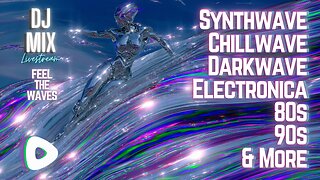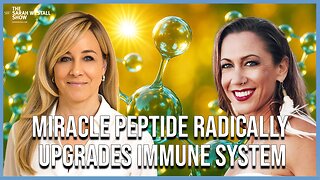Premium Only Content

Catalysts and Enzymes
For Employees of hospitals, schools, universities and libraries: download up to 8 FREE medical animations from Nucleus by signing up for a free trial at: http://nmal.nucleusmedicalmedia.com/biology_youtube
#catalysts #enzymes #ActivationEnergy
SCIENCE ANIMATION TRANSCRIPT: Today, we're going to talk about catalysts and enzymes. To understand enzymes, we need to know that chemical reactions require energy to occur. Recall that chemical reactions break the chemical bonds in reactants and rearrange those bonds to make products. Let's look at an energy diagram to see how energy changes as a chemical reaction progresses. At the start of a reaction, the reactants will have some amount of energy. If the products end up with more energy than the reactants had at the beginning, then this means the reaction absorbed energy from the environment. This is called an endothermic reaction. However, if the products end up with less energy than the reactants, then this means the reaction released energy. This is called an exothermic reaction. Either way, notice the peak in the energy hill just before the products begin to form. This peak represents the minimum energy the reactants required for the reaction to take place. The reactants need this energy to break their chemical bonds so that different bonds can be formed to make new products. This minimum amount of energy required for a reaction to take place is called activation energy. If the activation energy isn't reached, no reaction takes place. Sometimes, scientists need to make a reaction happen faster. If you want to speed up a reaction, you could increase the energy of the reactants by increasing their temperature, or you could add something called a catalyst. A catalyst is a substance that catalyzes or speeds up a chemical reaction without it being changed or used up by the reaction. Catalysts work by lowering the activation energy needed for the reaction to take place. By requiring less energy, catalysts make reactions happen faster and more efficiently because more of the reacting particles are likely to have sufficient energy or activation energy. And the higher the catalyst concentration, the faster the reaction takes place. Since catalysts aren't changed or used up by a reaction, they're available to catalyze more reactants. Chemical reactions are done in labs, but many chemical reactions also happen constantly inside your body. In living organisms, many reactions require catalysts. Biological catalysts are called enzymes. An enzyme is always made up of proteins. Proteins are one of the four types of organic compounds. We'll discuss them in more detail separately. Enzymes make life possible by lowering the amount of activation energy needed and, therefore, speed up reactions that would otherwise take too long. You need enzymes to stay alive. A reactant acted upon by an enzyme is called a substrate. Each enzyme has a unique active site that only a certain substrate can attach to, like a very specific puzzle piece. When attached, they form what is called an enzyme-substrate complex. This fit between an enzyme and substrate is so specific that it's often compared to a lock and key. When the substrate attaches to the enzyme, the enzyme lowers the activation energy needed to break the bonds in the substrate. Once the bonds break in the substrate, it separates into multiple components called products, which leave the active site. Afterward, the enzyme is still available to participate in another reaction with the same type of substrate. So, what factors affect how well an enzyme works? Well, enzymes work best around particular pH levels and certain temperatures, and the presence or absence of other chemicals can also impact their effectiveness. Not surprisingly, humans and other organisms have adapted to use enzymes that are most effective at the organism's natural temperature and pH values. To sum up, chemical reactions require energy to break the reactants' chemical bonds. The minimum amount of energy required for a reaction to happen is called the activation energy. Catalysts speed up reactions by lowering the activation energy. Catalysts aren't used up by chemical reactions. Biological catalysts are called enzymes. Enzymes are made of proteins. Enzymes act on reactants called substrates. Substrates bind to unique locations called active sites on enzymes. And factors that affect how well an enzyme works include pH, temperature, and other chemicals.
NSV16023
-
 4:14:29
4:14:29
SynthTrax & DJ Cheezus Livestreams
1 day agoFriday Night Synthwave 80s 90s Electronica and more DJ MIX Livestream Feel The Waves Edition
32.3K1 -
 2:09:19
2:09:19
Side Scrollers Podcast
8 hours agoNerd Duel Tournament of Champions! Who Will Win?!
59.4K5 -
 8:53:50
8:53:50
SpartakusLIVE
10 hours agoNEW Easter Egg, SPECIALIST || Duos w/ @GloryJean followed by quads later!
60.4K1 -
 1:40:06
1:40:06
Glenn Greenwald
9 hours agoAaron Maté and Special Guests on the U.S. Role in Ukraine, Gaza's Future & More | SYSTEM UPDATE #462
162K109 -
 3:49:09
3:49:09
Nerdrotic
13 hours ago $23.43 earnedSuperman's James Gunn Reshoots, Harry Potter DOA! R.I.P. Winds of Winter | Friday Night Tights 356
117K17 -
 2:23:47
2:23:47
DasNello
6 hours agoLADIES AND GENTLEMEN, I PRESENT ELDEN RING NIGHT REIGN!!!
28.7K1 -
 5:35:38
5:35:38
tacetmort3m
6 hours ago🔴 LIVE - LAST STREAM BEFORE DUNE? - NO MORE ROOM IN HELL 2
22.6K -
 1:14:57
1:14:57
Sarah Westall
9 hours agoGame Changing Peptide Increases Immunity 50 to 100x Better than Nutrition Alone w/ Dr. Diane Kazer
40.1K6 -
 9:14:52
9:14:52
Dr Disrespect
16 hours ago🔴LIVE - DR DISRESPECT - WARZONE - SNIPING AND WINNING
208K14 -
 2:13:56
2:13:56
Barry Cunningham
11 hours agoBREAKING NEWS: PRESIDENT TRUMP GIVES SPEECH AT PITTSBURGH RALLY!
49.5K28